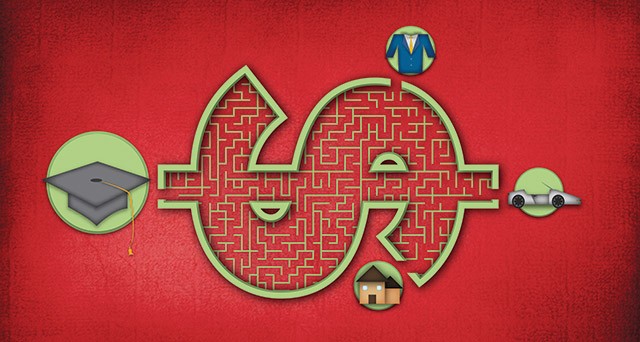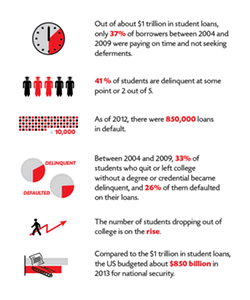[
{
"name": "500x250 Ad",
"insertPoint": "5",
"component": "15667920",
"parentWrapperClass": "",
"requiredCountToDisplay": "1"
}
]
Melissa Nicholson had a bachelor's and a master's degree in education, and zero job prospects.
"I discovered I couldn't get a job just being certified to teach elementary school," she says. "But I thought, 'Even though I'm swamped in loans already, there's no way I can turn back now that I've come this far.'"
Nicholson, who wants to teach in the Rochester City School District, went on to earn a post-graduate certification to teach English as a second language. Though her ESL certification has made her more marketable, she says, she still hasn't landed a permanent teaching job.
Nicholson now owes about $80,000 in student loans, and will soon be faced with a $600 monthly payment. For now, she's surviving on what she makes as a substitute teacher, and she estimates she could be 61 before she pays off her student debt.
It's not hard to find people — some still in college and recent graduates — with $20,000 to $100,000 in student loans. All it takes is a query over Twitter or Facebook, and the responses from the financially weary appear with startling speed.
Some economists call student debt the next economic crisis, warning that the bubble may be about to burst. The Federal Reserve Bank of New York reports that unpaid debt on student loans is about $902 billion, but the Consumer Finance Protection Bureau says it tops $1 trillion.
Some college administrators and financial aid officers say the problem of student debt is vastly overstated, but many students, parents, and educators strongly disagree. Some students and former students say their debt is so high that even if they are fortunate enough to get a job in this sluggish economy, they will still have to postpone major life decisions like marriage and having children.
Others say their debt is unsustainable, and question whether they'll ever be able to pay it off. As of 2012, more than 850,000 student loans were in default.
Deb Schleede graduated from the Rochester Institute of Technology last year with an undergraduate degree in journalism and nearly $80,000 in student loans.
"I completely exhausted federal and state aid," she says. "Because I had a single mom, I did get what I consider a very decent amount of aid. But RIT is expensive and it didn't cover all of it."
Though Schleede hasn't been able to find a job in journalism, she does work full time in retail. She says she tries not to think about her debt because it overwhelms her.
"One of my loans is $516 a month, and when you add them all together, it's more than I make in one pay period," she says. "I would have to be making more than $60,000 a year to make the payments comfortably."
The student loan crisis raises many questions: What are the implications of all this debt on the US economy? How can these young people ever hope to purchase big-ticket items like houses and cars? Is the debt fair? The nonprofit Center for American Progress reports that 81 percent of African-American students and 61 percent of Latino students who earned bachelor's degrees last year graduated with debt.
And most important: the cost of tuition at four-year public and private colleges, according to CFAP, has increased by more than 1,000 percent over the last three decades, putting the rising cost of higher education on par with the rising cost of health care. Is it good policy in a global economy to have the cost of a college education outpace the rate of inflation? Most economists shudder at the thought.
Some economists, however, say it's OK for students to have some debt — it gives them skin in the game. And higher education should be left to the forces of the free market, they say. The problem with that argument is that the playing field isn't level. Students can defer their debt, but student loans are among the few debts in the US that can't be discharged through bankruptcy.
Administrators and financial aid officers at some institutions have their own view of the student debt problem. Jonathan Burdick, dean of admissions and financial aid at the University of Rochester, says about 50 percent of the UR's students are from families who can afford to pay for their children's education.
Every college has some percentage of students who don't have to borrow, Burdick says. Otherwise, financing college requires navigating a maze of federal and state loans, private lender loans, grants, and scholarships. The search for aid typically begins with filing a Federal Application for Student Aid, or the FAFSA form. Most institutions' websites will direct applicants to the form.
UR students and parents who need financial assistance may receive some help from the UR, but Burdick says they may also be expected to borrow money.
"There's a share of students marching through here who can expect to graduate owing $30,000 to the federal government," Burdick says. "Any other borrowing above that amount by our definition is an elected choice."
And for a degree from the UR, he says, some debt is not excessive.
Burdick cites a lack of financial discipline on the part of some students and parents as one of the main problems. And he says the basic financial aid calculations that institutions use hasn't changed much in 40 years.
"A family with an income of $100,000 with two children, and one of them in college, can typically afford to spend $20,000 to $25,000 [annually] on college expenses," he says. "It's not comfortable, but it's doable. It's definitely not the time to go out and buy a house."
But some parents are assuming debt and not making the sacrifices necessary to pay their portion of the bill, Burdick says.
"It's the same category of debt from a moral standpoint as credit card debt," he says. "You're choosing not to change your lifestyle at all, but you're assuming a pretty heavy level of extra debt responsibility toward college."
Burdick says he's worried that some discretionary debt is being lumped with college-related debt.
"Somewhere in there somebody is making a choice," he says. "I'm sympathetic and all because of the recession, but the choices being made seem to have changed a bit."
Samantha Veeder, director of financial aid at Nazareth College, agrees. During the more than 20 years she has worked in financial aid, she says she's watched the public's attitude toward debt change.
"People respond to debt differently," she says. "If a student takes the maximum in federal loans — about $27,000 — the monthly payment is going to be about $300 a month for 10 years. If you can receive a good four-year education at or under $30,000, you've done well; you've made an excellent investment in yourself and your career. Some parents won't even blink an eye at $30,000, and others will say, 'Absolutely not. You are not coming out of college $30,000 in debt.'"
And Veeder cites another problem: many children and parents are not financially literate.
"I say this with my own child in mind: kids don't understand money," she says. "They don't know how to balance a checkbook. They don't know how to open a bank account. They only know how to spend."
Like many higher ed institutions, Nazareth is putting more emphasis on educating students about their loan commitments. But Veeder says it's still a challenge.
"Generally speaking, especially with freshmen and sophomores, they're not listening," she says. "They'll sign whatever they have to sign: 'just give me the loan.'"
But for those students and parents who are financially savvy, Veeder says she's seeing a reaction that's relatively new.
"This generation of parents wants to know the outcome," she says. "'What's the return on investment? If my child goes $30,000 into debt, is he going to get a job?'"
The high cost of college may be causing some students to reassess the purpose of education and the value of a bachelor's degree. Should they go to college to develop critical thinking and innovation, or to train for a job? Should they pursue what they most enjoy or be more pragmatic?
And should college administrators be expected to justify their tuitions with some quantification of how many of their graduates are employed in their chosen fields?
This is where the financial piece between students and school administrators gets a little sketchy. With an economy struggling to emerge from one of the country's worst recessions, the job market is especially chilly for recent graduates.
A lot depends on the fields students choose, Veeder says. A student leaving Nazareth with a graduate degree in physical therapy, for example, is much more likely to find employment sooner and at a higher starting salary than a teacher at this time, she says.
"I have friends who have degrees, but they're working two and three jobs to pay for it," says recent graduate Deb Schleede. "Some are thinking of going back to college to get a master's. I'm very honest with them about the situation I'm in, and I caution them to think about the finances involved with it, and make sure they understand they're not going to get rid of their debt easily."
It's difficult to gauge how much financial or career counseling students receive or how much they need, since every student is different. Amanda Ott went to cosmetology school and still owes the $10,000 she borrowed to become a hairdresser. She works full time in a shop near RIT and says she's on track to earn her bachelor's degree in education at SUNY Brockport in 2015.
Ott figures she owes about $30,000, and says she doesn't remember receiving financial or career counseling.
"I think if I had received it, I would have gone to a community college for two years first," she says. "The debt becomes a means to an end, and you're not really considering the implications of the debt at the time."
Substitute teacher Melissa Nicholson says she never sat down and calculated what she would make as a teacher and how she would repay her loans and have enough money to live on.
"I didn't look at what I would be making, and here's what would go toward groceries, car, and rent," Nicholson says.
She says she followed the conventional advice given to young people: go to college and pursue your passion. She says she knew teaching isn't a high-paying career, but it wasn't until she was already in debt that she learned more about the field. And while changing direction is possible, it often requires going further into debt.
"It's [debt] sort of the challenge of my generation," Nicholson says. "Unless you want to be a pharmacist or a nuclear engineer or one of these other high-paid professionals, it's not a good situation. But I don't know what the alternative is. Among people my age, you just assume there is debt. I feel like my whole generation is drowning in debt."
Ballooning student debt has put some college officials on the defensive. Though administrators say that the number of non-medical students with excessively high debt is still small, the issue is shining a spotlight on the staggering cost of a college education.
And the question that nearly everyone asks: Why is it so high?
"The inflation factor is huge," says the UR's Burdick. "But we're now operating in a global environment, and this is a research university. If we're not willing to pay $300,000 a year for a superstar economist or a million dollars for a leading scientist, some other university is."
And much of a university's expenses are fixed, he says.
"There's no way we can get the benefits of a Ford [Motor Company] that could ship 80 percent of its manufacturing to some low-wage place," he says. "We're a services business and just about all of those services are performed right here."
Amit Batabyal, a professor of economics at RIT, says that advances in technology don't always translate to significant cost savings in higher education.
"You still require dormitories and you still require lecture rooms," he says.
The problem is exacerbated by parents' and students' high expectations of the college experience, he says.
RIT is making an effort to keep tuition increases down through internal cost-savings and efficiencies, Batabyal says, and he predicts that online education will transform higher education.
"A student, let's say, in Pakistan can take a course by Amit at RIT," he says. "This is the wave of the future."
Batabyal says Americans have put all students on one track that leads to college. While it's true that higher education leads to better paying jobs and more stable employment, it's also true that the US has failed to give students more vocational school options, he says.
Germany has been able to maintain a sizeable manufacturing base that provides workers with a reasonable income, Batabyal says.
"In Germany, a significant number of kids don't go to college, but Germany has a number of vocational schools," he says. "That as a society is something we've failed to do."
But Batabyal is most concerned with federal and state spending priorities that have recently confronted an anti-tax culture.
"Higher education is being tested in ways that it hasn't before," he says. "Cash-strapped states are whittling down their support for student aid. This increases reliance on debt. State governments are going to have to decide if it makes sense to decrease their support for education and increase their investment in things like prisons. It's a very lopsided investment."
The result is higher education that's increasingly unaffordable to many Americans, Batabyal says, which drives unemployment and underemployment.
Speaking of...
Latest in News
More by Tim Louis Macaluso
-

RCSD financial crisis builds
Sep 23, 2019 -

RCSD facing spending concerns
Sep 20, 2019 -

Education forum tomorrow night for downtown residents
Sep 17, 2019 - More »













